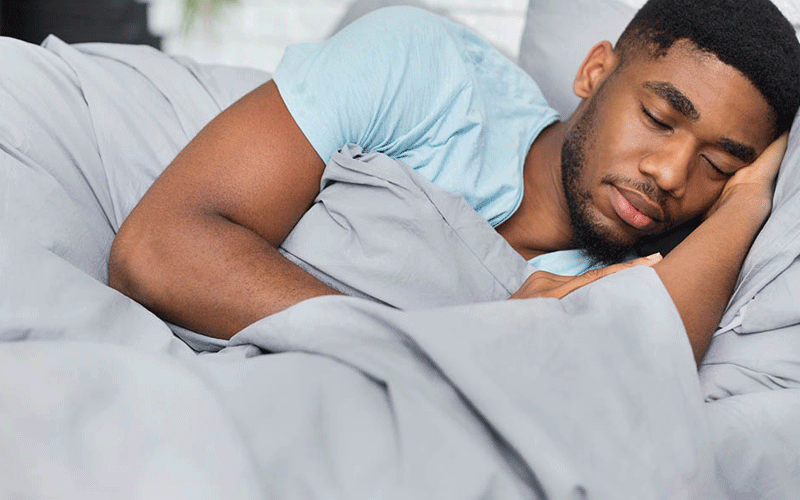Ten sleep positions and how they affect your health

With so much attention given to how long you get your Zzzs each night and how you feel when you wake up, it’s easy to forget that there’s another key player in the good sleep equation; how you lie down. Unfortunately, the position that you find most comfortable might end up causing health problems, ranging from aches to sleep apnea and even premature wrinkling. Milliam Murigi explores the pros and cons of each.
1. Sleeping on your back (Supine)
It’s quite a rare thing to sleep on ones back, as just eight per cent of people do.
If you do, the good news is that sleeping face up is great for preventing neck and back pain.
Lying flat on your back keeps your head, neck and spine in a neutral position, removing extra pressure on the joints in those areas.
The main drawback of sleeping on your back is that it increases your risk of snoring or sleep apnea.
This is because when you lie flat on your back, your tongue can block your breathing tube, making it harder to breathe normally.
2. Sleeping on your left side
Left side sleeping is by far the most common and best sleeping position and the most recommended one.
This position reduces symptoms of sleep apnea and can ease snoring.
Sleeping on your left side doesn’t affect the cardiovascular system, meaning your heart can easily pump blood throughout your body.
3. Sleeping on your right side
Your right side houses your cardiovascular system, so adding pressure on this part of the body actually constricts your rib cage and strains your lungs.
If you use this position, you are likely to experience acid reflux and even heart failure.
4. Sleeping on your tummy (Prone)
Just seven per cent of adults prefer this position. If you are part of those statistics, it’s worth trying a new position because sleeping on your tummy carries several risks.
Firstly, it’s hard to keep your spine in a neutral position when lying on your tummy, and this can lead to neck and back pain.
Secondly, this position puts pressure on your joints and muscles, which can trigger aches, numbness and tingling.
It’s best to avoid sleeping in this position altogether, but if it’s the only position you can sleep in, reduce the potential risks by sleeping face down instead of with your head turned to the side.
This will help keep your airway open and propping a softer pillow slightly under your forehead
5. Sleeping in a foetal position
Around 40 per cent of people curl up on their side at night. It’s good news if you fall into this group because the foetal position keeps the spine neutral, helping to prevent back pain.
Animal research suggests that curling up on your side may help to reduce your risk of brain conditions, such as Alzheimer’s and Parkinson’s disease.
But this sleeping position brings other advantages. Pregnant women may benefit from lying in the foetal position at night because doing so: improves circulation in your body, improves your baby’s circulation and prevents your uterus from pressing against your liver.
However, curling up too tightly for the whole night can restrict your breathing and make you feel sore. Stretch out a bit. A more relaxed back encourages easy breathing.
6. The soldier position
In this position, the sleepers lie on their backs and their arms are down and close to the body, unlike in supine where you lie with no specific arms position.
Approximately, eight per cent of people sleep like this. This one is a poor choice for snoring and may prevent you from getting a restful night’s sleep.
This position can help spread pressure evenly across the length of the spine, neck and arms.
And when the mattress is too firm, this position can sometimes cause lower back pain.
7. The starfish position
People who sleep in a starfish position sleep on their backs with their arms up over their heads.
Approximately, five per cent of people sleep this way. This position is beneficial in terms of resting the spine and maintaining a healthy posture.
However, the placement of the arms can place excess pressure on the shoulders, causing pain if sustained for long periods of time.
People who sleep in this position may also be prone to snoring and sleep problems.
8. The log position
People who sleep in the log position sleep on their sides with their arms down next to their bodies.
Approximately 15 per cent of people sleep like a log. This can be a beneficial sleep position for spinal health, as it typically supports good posture and does not place undue pressure on the back and neck.
However, as your top leg does not receive the same support as your lower leg, some sleepers may experience hip pain and if you have arthritis, you may wake up in pain.
Often, people find that placing a pillow between the thighs can aid pressure relief.
9. The spooning position
Spooning is a side sleeping position for couples; the person in the back holds the one in the front close to their body.
As with other postures, this one comes with its own advantages and disadvantages.
As for disadvantages, couples may wake up more frequently sleeping this way, as you are more likely to be jostled by your partner.
But spooning allows for cuddling, too, which stimulates the release of oxytocin.
This is a hormone that promotes bonding, decreases stress, and may help you get to sleep more quickly.
10. Sleeping upright
Sleeping with your head raised is possible when dozing on a chair or increasing the number of pillows under the head and upper back.
However, when you sleep upright, your neck tends to strain and drop to one side, causing pain.










